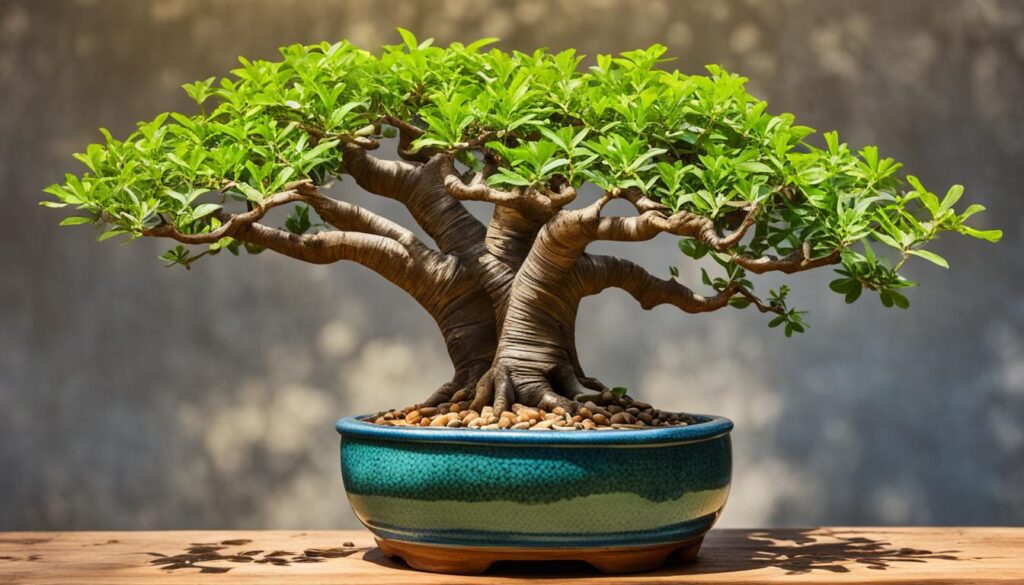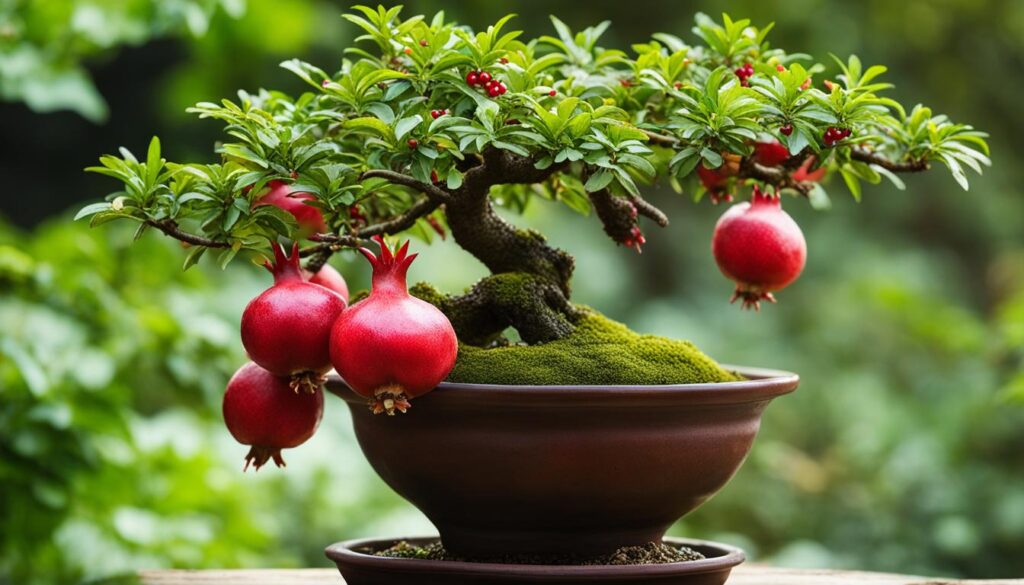Welcome to our guide on caring for bonsai pine trees. This article covers essential aspects of bonsai pine care, including ideal species, maintenance techniques, placement, and sunlight requirements.
Proper care is vital for the health of your bonsai pine trees. By following best practices, you can maintain their beauty for years. We will discuss watering, drainage, fertilization, pruning, pest protection, and advanced care techniques.
Key Takeaways
ToggleUnderstanding the Basics of Bonsai Pine Trees

In this section, we will delve into the fundamentals of bonsai pine trees, providing you with an introduction to this unique art form and the specific characteristics of pine trees that make them ideal for bonsai cultivation.
Bonsai, which translates to “tray planting” in Japanese, is the art of growing miniature trees in containers. It originated in Japan and has since become popular worldwide for its aesthetic appeal and meditative qualities.
When it comes to bonsai pine trees, it’s important to understand their specific growth patterns and characteristics. Pine trees are known for their distinct needle-like foliage and sturdy branches. These qualities make them particularly suitable for shaping and training in the bonsai style.
Bonsai pine trees require careful pruning and wiring to create the desired shape and form. The branches can be wired and shaped to achieve the desired curvature and overall design. Additionally, pine trees have the unique ability to produce back budding, allowing for the creation of fine ramification and dense foliage pads.
In the words of renowned bonsai artist Ryan Neil, “Understanding the fundamental principles of pine growth and the interplay between foliage, twigs, and branches is essential to achieving convincing and beautiful pine bonsai trees.”
Bonsai, including pine trees, has a rich history and carries cultural significance. The art form originated in Japan over a thousand years ago and has deep roots in Japanese culture and philosophy. Bonsai represents harmony, patience, and respect for nature, and it is seen as a form of meditation and self-expression.
Next, we will explore the different pine species that are commonly used for bonsai and learn about their unique characteristics and care requirements.
Identifying the Ideal Pine Species for Bonsai
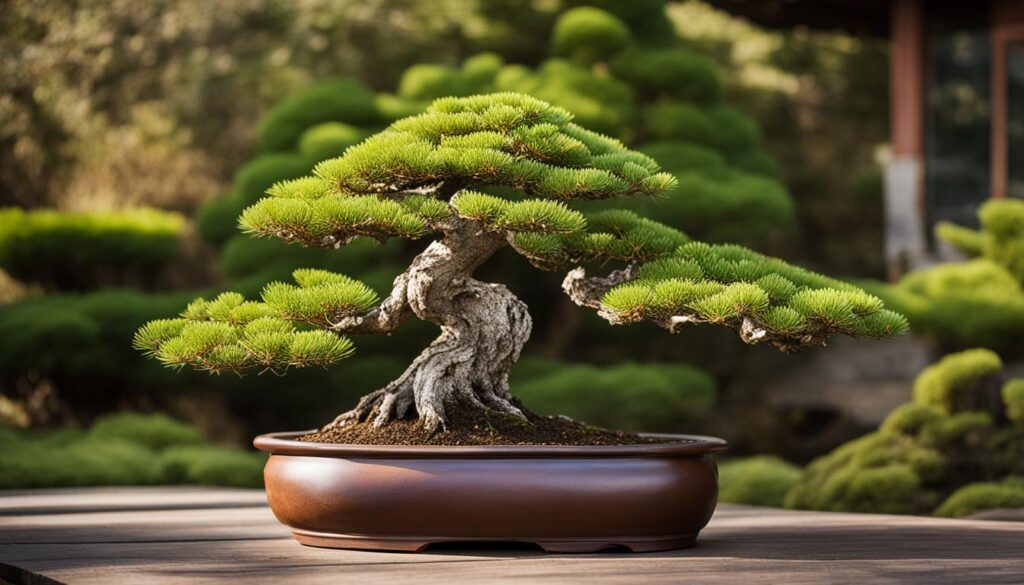
When it comes to bonsai pine trees, choosing the right species is crucial for the overall success and aesthetics of your miniature masterpiece. Different pine species offer unique growth patterns, foliage characteristics, and overall suitability for bonsai cultivation. In this section, we will explore the various pine species that are commonly used for bonsai, helping you make informed decisions about the best pine species for your bonsai collection.
Two Flushes of Growth: Japanese Black and Red Pines
Japanese Black Pine (Pinus thunbergii) and Japanese Red Pine (Pinus densiflora) are two prime examples of pine species that exhibit two flushes of growth per year. These pines are highly sought after by bonsai enthusiasts for their distinctive needle clusters, excellent branching characteristics, and the ability to develop intricate trunk formations over time. The dual flushes of growth provide ample opportunities for refinement and styling.
Japanese Black Pine is known for its dark green foliage, rugged bark, and graceful appearance. It lends itself well to a variety of bonsai styles, including formal upright, informal upright, and slanting. Japanese Red Pine, on the other hand, features elegant, lustrous needles and an attractive reddish-brown bark. It is favored for its versatility and adaptability to different bonsai techniques and styles.
Both Japanese Black Pine and Japanese Red Pine require careful attention to pruning and candle management to maintain their desired shape and density. With their stunning aesthetics and growth characteristics, these pines are highly recommended for bonsai enthusiasts interested in creating refined and visually striking specimens.
One Flush Pines: Japanese White Pine and Others
Japanese White Pine (Pinus parviflora) is a popular choice for bonsai enthusiasts due to its elegant appearance, delicate needles, and unique bonsai-friendly growth habit. As a one-flush pine species, it produces new growth in spring, allowing for focused development and styling. Japanese White Pine is known for its graceful, flexible branches and attractive grayish-white bark, making it an excellent option for formal upright and cascade-style bonsai.
Aside from Japanese White Pine, several other pine species fall into the one-flush category. Scots Pine (Pinus sylvestris), Ponderosa Pine (Pinus ponderosa), Mountain Pine (Pinus mugo), and Bristlecone Pine (Pinus aristata) are noteworthy examples. Each of these species possesses unique characteristics, such as interesting bark textures and foliage variations, which can add depth and visual interest to your bonsai collection.
When selecting a one-flush pine species for bonsai, consider factors such as regional suitability, climate compatibility, and the specific requirements of the species. The diversity and beauty of one-flush pines make them a compelling choice for both bonsai beginners and experienced enthusiasts.
Essential Bonsai Pine Tree Maintenance Techniques
Proper maintenance is crucial for the health and longevity of bonsai pine trees. By implementing essential techniques and following best practices, you can ensure that your bonsai pines thrive and flourish in their miniature form. This section will guide you through the fundamental maintenance techniques that are essential for caring for bonsai pine trees.
1. Watering: The key to successful bonsai pine tree care lies in maintaining the right balance of moisture. It is important to water your bonsai pine regularly, ensuring that the soil is moist but not waterlogged. Use your finger to check the moisture level in the soil; if it feels slightly dry, it’s time to water. Avoid overwatering, as it can lead to root rot and other issues.
2. Soil and Pot Selection: The choice of soil and pot plays a crucial role in the health of your bonsai pine tree. Use well-draining soil specifically formulated for bonsai trees. Consider repotting your bonsai pine every two to three years to refresh the soil and promote root development. Choose a pot that allows for proper drainage and has enough space for the root system to grow.
3. Fertilization: Fertilizing your bonsai pine tree is vital to provide essential nutrients for growth and maintain its health. Use a balanced liquid fertilizer during the growing season, following the manufacturer’s instructions. Avoid over-fertilizing as it can lead to excessive growth and weaken the tree. Adjust the fertilizing schedule based on the specific needs of your bonsai pine.
4. Pruning and Wiring: Pruning and wiring techniques help shape your bonsai pine tree and maintain its desired form. Regular pruning helps control growth, promote branch development, and enhance the overall aesthetics of the tree. Wiring is used to guide the growth of branches and create appealing shapes. Be careful not to apply excessive force during wiring, as it can damage the delicate branches of the bonsai pine.
5. Repotting: Repotting is necessary to provide fresh soil and maintain the health of the root system. Repot your bonsai pine every two to three years, preferably during the spring season. Carefully remove the tree from its pot, trim the roots, and replant it in fresh soil. Repotting helps prevent root-bound issues and stimulates new growth.
6. General Care Tips: In addition to the specific maintenance techniques mentioned above, there are a few general care tips to keep in mind when caring for bonsai pine trees. Place your bonsai pine in a location that receives ample sunlight, avoiding extreme temperatures and drafts. Monitor your tree for any signs of pests or diseases, and take prompt action if detected. Regularly clean the tree’s leaves and remove any dead or yellowing foliage.
By following these essential bonsai pine tree maintenance techniques, you can create a thriving and visually captivating miniature tree that brings tranquility and beauty to your space. Implementing proper care practices will ensure that your bonsai pines continue to flourish for years to come.
Bonsai Pine Tree Placement and Sunlight Needs

Positioning Your Bonsai for Optimal Growth
Proper placement is crucial for the healthy growth of your bonsai pine tree. When deciding where to position your bonsai, consider factors such as light intensity, direction, and duration. Placing your tree in the right spot will ensure it receives the sunlight it needs to thrive.
First, identify a location that offers the ideal amount of sunlight for your bonsai pine tree. Different pine species have varying sunlight requirements, so it’s important to research and understand the specific needs of your tree.
Generally, bonsai pines require bright, indirect sunlight. Avoid placing them in full, direct sunlight for extended periods, as this can scorch the foliage. Instead, opt for a location with partial sun or filtered light, such as near a window with curtains or in a spot that receives morning or late afternoon sun.
Additionally, consider the position of your bonsai within its surroundings. Placing it on a south-facing windowsill or patio may provide ample sunlight, but it could also expose the tree to strong winds or extreme temperatures. Protect your bonsai pine tree from these harsh conditions to prevent stress and damage.
When positioning your bonsai, aim to provide consistent sunlight throughout the day. Rotating the tree periodically can ensure that all sides receive equal light exposure, promoting balanced growth.
Benefits of Adequate Sun Exposure
Adequate sunlight is essential for the health and development of your bonsai pine tree. Here are some benefits of providing your tree with the right amount of sun:
- Enhanced growth: Sunlight is a crucial energy source that fuels photosynthesis in your bonsai tree. Sufficient sunlight allows the tree to produce the necessary carbohydrates for growth.
- Color development: Sunlight plays a key role in the formation of pigments that give your bonsai pine tree its vibrant color. With proper sun exposure, your tree’s foliage will develop rich, deep hues.
- Overall tree health: Sunlight stimulates the production of essential nutrients and strengthens the tree’s immune system, helping to combat pests and diseases.
Remember, while sunlight is important, it’s equally crucial to strike a balance. Overexposure to direct sunlight can harm your bonsai pine tree, so monitor its response and make adjustments as needed.
| Sunlight Intensity | Light Duration | Ideal Placement |
|---|---|---|
| Bright, indirect sunlight | 6-8 hours per day | Near a window with curtains or in a spot that receives morning or late afternoon sun |
| Partial sun or filtered light | 4-6 hours per day | An east-facing windowsill or a shaded area in your garden |
| Full sun | 2-4 hours per day | A south-facing windowsill or patio with protection from strong winds and extreme temperatures |
Watering and Drainage for Bonsai Pine Trees
Proper watering and drainage are crucial for the health and vitality of bonsai pine trees. In this section, we will dive into the essential techniques and practices to ensure your bonsai pines thrive.
When it comes to watering your bonsai pine, it’s important to strike a balance. Too much water can lead to root rot and other moisture-related problems, while too little water can cause dehydration and stress. The frequency and volume of watering will depend on various factors such as the climate, pot size, and soil composition.
To determine when it’s time to water your bonsai pine, a simple yet effective method is to check the moisture level of the soil. Insert a finger about an inch deep into the soil. If it feels dry, it’s time to water. However, if it feels moist, it’s best to wait before watering again.
When watering your bonsai pine, it’s important to do so evenly and thoroughly. This ensures that the entire root system is adequately hydrated. Avoid watering only the surface of the soil, as it can lead to shallow root growth. Instead, water until you see it flowing out of the drainage holes at the bottom of the pot.
Another critical aspect of bonsai pine tree care is proper drainage. Good drainage is essential to prevent waterlogging and root rot. Ensure that your bonsai pot has sufficient drainage holes to allow excess water to escape.
Drainage screens or mesh can also be used to prevent soil from washing out of the pot while still allowing water to flow through. Additionally, using well-draining soil compositions that include components such as perlite or pumice can help improve drainage.
Key Fertilization Practices for a Thriving Bonsai Pine

In order to ensure optimal growth and health for your bonsai pine tree, proper fertilization is essential. Providing the right nutrients is especially important for weak trees that need extra support. Additionally, understanding the impact of candle cutting on fertilizing schedules is crucial, particularly for two-flush pines. Here are some key fertilization practices to follow for healthy bonsai trees.
Feeding Weak Trees Year-Round
Weak bonsai pine trees require consistent feeding throughout the year to help them regain their strength. By providing a balanced fertilizer enriched with essential nutrients, you can promote healthy growth and combat weakness. It is recommended to use a slow-release fertilizer to ensure a steady and continuous supply of nutrients. Apply the fertilizer according to the manufacturer’s instructions and adjust the dosage based on the tree’s specific needs.
Adjusting Fertilizing Schedules Based on Candle Cutting
Candle cutting is a technique used in the maintenance of two-flush pines. It involves removing a portion of the tree’s new growth to encourage denser and more compact foliage. This pruning method has an impact on the fertilizing schedule of your bonsai pine. After candle cutting, it is crucial to reduce the amount of nitrogen-based fertilizer to prevent excessive growth. Instead, focus on using a balanced fertilizer with lower nitrogen content to promote overall health and balanced development.
| Fertilizer Type | Nitrogen (N) | Phosphorus (P) | Potassium (K) |
|---|---|---|---|
| Slow-release granular fertilizer | Low | Medium | Medium |
| Organic liquid fertilizer | Low | Low | Low |
| Water-soluble fertilizer | High | Medium | Medium |
When choosing a fertilizer for your bonsai pine tree, consider the specific nutrient requirements of the tree species and adjust the fertilizer’s composition accordingly. The table above provides a general overview of different fertilizer types and their nitrogen (N), phosphorus (P), and potassium (K) contents. Remember to always follow the instructions provided by the fertilizer manufacturer, as different brands may have specific guidelines for dosage and application frequency.
Pruning and Wiring Bonsai Pines: Enhancing Aesthetics and Growth
Pruning and wiring are essential techniques for maintaining the aesthetics and promoting healthy growth of bonsai pine trees. By selectively removing branches and shaping the tree, you can create stunning and unique designs that mimic the majestic beauty of full-sized pine trees. Additionally, wiring allows you to guide and position branches, further enhancing the overall appearance of your bonsai pine.
Pruning Techniques for Bonsai Pine Trees
Proper pruning is crucial for maintaining the shape and balance of your bonsai pine tree. Here are some steps to follow:
- Start by evaluating the overall structure of your tree. Look for any branches that disrupt the desired shape or hinder the flow of the design.
- Using sterile and sharp bonsai pruning shears, carefully remove the unwanted branches. Make clean cuts close to the trunk or main branch, ensuring that no stubs are left.
- Avoid pruning more than one-third of the tree’s foliage at a time to prevent stress. Regularly assess the tree’s growth to determine when additional pruning is required.
- Consider the desired style of your bonsai pine when pruning. For example, in the formal upright style, maintain a straight and symmetrical trunk with gradually tapering branches. In the informal upright style, create a more natural and asymmetrical shape. The cascading style involves allowing branches to cascade downward.
Remember: Pruning should be done during the tree’s dormant period, typically in late winter or early spring. This allows the tree to recover and heal properly before entering the active growth phase.
Wiring Techniques for Bonsai Pines
Wiring helps you shape and position the branches of your bonsai pine trees. Follow these steps to wire your tree effectively:
- Select high-quality, flexible bonsai wire suitable for your tree’s strength and thickness. Copper or aluminum wire is commonly used for bonsai pines.
- Start by securing one end of the wire to the base of the trunk or branch and gently wrap it around in a spiral motion, gradually moving toward the tip.
- Ensure the wire is tight enough to hold the branch in the desired position but not so tight that it damages the tree. Leave some space between the wire and the bark to prevent wire marks.
- Once the branch has been shaped, secure the other end of the wire by bending it back onto itself or using wire cutters to trim off any excess.
- Be mindful of the wire’s position as the tree grows. Remove the wire before it cuts into the bark or causes any damage. Typically, wiring is left in place for several months or until the branch has hardened into the desired shape.
Note: Regularly check your bonsai pine for any signs of wire cutting into the bark, making adjustments as necessary to prevent injury to the tree.
Repotting Tips for a Healthy Bonsai Pine
Repotting plays a crucial role in maintaining the health and vitality of your bonsai pine tree. Follow these tips for successful repotting:
- Repot your bonsai pine every 2-3 years to prevent root congestion and promote optimal growth.
- Timing is important. Spring is the ideal time for repotting as the tree enters the active growth phase.
- Choose a well-draining bonsai soil mix specifically formulated for pine trees. Avoid using regular potting soil, as it retains too much moisture.
- Gently remove the tree from its current pot, taking care not to damage the delicate root system. Use a root rake or chopstick to untangle and prune any long or overly thick roots.
- Place a layer of fresh soil in the bottom of the new pot and carefully position the tree, ensuring it is centered and at the desired height.
- Fill the remaining space with the bonsai soil mix, gently pressing it to secure the tree. Water the tree thoroughly to settle the soil.
Propagation Methods: Cultivating Your Bonsai Collection
Expanding your bonsai collection can be an exciting journey. Here are a few propagation techniques to help you cultivate new bonsai trees:
- Seeds: Collect seeds from mature pine cones and sow them in well-draining bonsai soil. Place the container in a warm and bright location, ensuring consistent moisture. Be patient, as pine seeds may take several months to germinate.
- Cuttings: Take semi-hardwood cuttings from healthy pine branches during the growing season. Remove the lower leaves and dip the cut end in rooting hormone before planting in a well-draining medium. Maintain high humidity and provide indirect light until roots develop.
- Air Layering: Select a healthy branch with desirable characteristics and make a small incision in the bark. Apply rooting hormone to the area and surround it with moist sphagnum moss. Wrap the moss with plastic wrap to create a humid environment. Once roots have formed, carefully remove the branch and pot it as a new bonsai tree.
Propagation techniques allow you to create unique bonsai trees while preserving the characteristics of the original pine species. Experiment with different methods to expand your collection and hone your skills as a bonsai enthusiast.
| Technique | Benefits |
|---|---|
| Pruning | – Shapes the overall aesthetics of the tree – Maintains balance and symmetry – Controls growth and encourages denser foliage |
| Wiring | – Allows precise positioning of branches – Enhances the natural flow and movement of the tree – Creates artistic designs and unique bonsai styles |
| Repotting | – Prevents root congestion and improves nutrient absorption – Promotes healthy growth and development – Refreshes the soil and enhances overall tree health |
| Propagation | – Expands your bonsai collection – Preserves unique characteristics of pine species – Provides an opportunity for experimentation and personalization |
Common Pests and How to Protect Your Bonsai Pine Tree
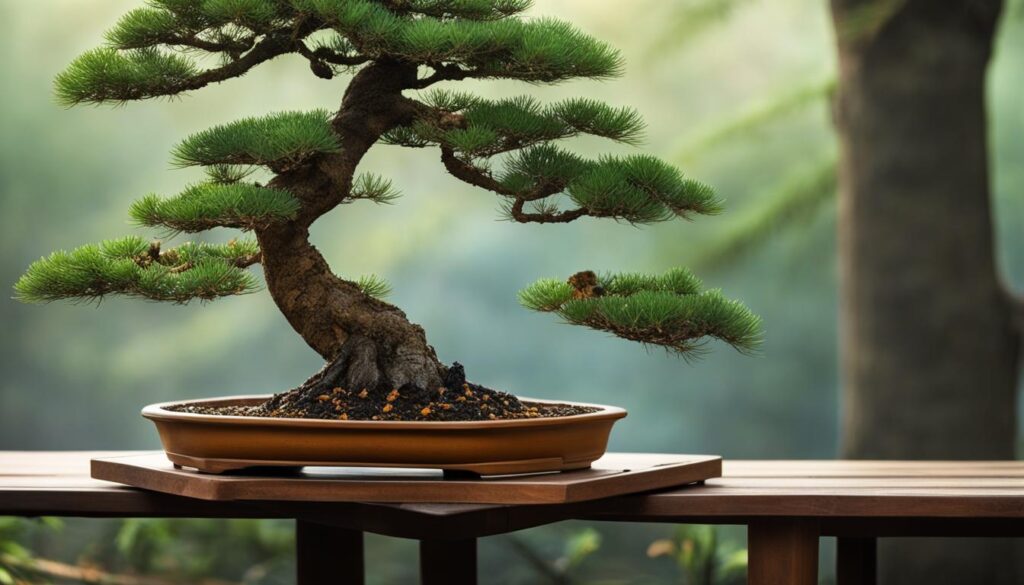
Pests can pose a significant threat to the health and vitality of your bonsai pine tree. Understanding the common pests that can affect bonsai pines and implementing effective pest control measures is essential for protecting your tree and ensuring its longevity.
Aphids: These small insects feed on the sap of bonsai pine trees, causing leaf curling and discoloration. To control aphids, regularly inspect your tree for signs of infestation and gently wash them off with a strong stream of water. In severe cases, consider treating your tree with an insecticidal soap or neem oil.
Spider Mites: Spider mites are tiny pests that can infest bonsai pine trees, causing yellowing leaves and webbing. To prevent spider mite infestation, regularly mist your tree to increase humidity and inspect the undersides of leaves for mites. In case of an infestation, treat your tree with a miticide, following the manufacturer’s instructions.
Scale Insects: Scale insects are small, immobile pests that attach themselves to the bark of bonsai trees. They feed on sap, causing yellowing leaves and a sticky residue. Remove scale insects from your tree by gently scrubbing them with a soft brush dipped in rubbing alcohol. Repeat the process regularly until the infestation is under control.
Caterpillars: Caterpillars can defoliate bonsai pine trees if left unchecked. Hand-pick the caterpillars from your tree and destroy them. If the infestation is severe, consider using an organic biopesticide to control their population.
In addition to pests, bonsai pine trees can also be susceptible to common diseases and issues such as fungal infections and root rot. To prevent these problems, ensure proper watering practices, avoid overwatering, and maintain good air circulation around the tree.
“Preventive measures and prompt action are crucial in protecting your bonsai pine tree from pests and disease. Regularly inspect your tree, provide optimal care, and address any issues promptly to ensure its health and vitality.”
To protect your bonsai pine tree from pests, it is important to be proactive and implement preventive measures. Regularly inspect your tree for signs of pests, such as yellowing leaves, leaf curling, or webbing. Additionally, practice good hygiene by keeping the soil surface clean and removing any fallen leaves or debris that may harbor pests. Prune and remove any infected or damaged branches to prevent the spread of pests or diseases.
By maintaining a healthy environment and providing proper care, you can significantly reduce the risk of pest infestations and protect the overall well-being of your beloved bonsai pine tree.
Advanced Techniques: Candling and Seasonal Care Adjustments
As you become more experienced in caring for bonsai pine trees, you can explore advanced techniques to enhance their growth and maintain their health. Two of these techniques are candling and making seasonal care adjustments. Understanding these techniques will allow you to take your bonsai pine care to the next level.
Seasonal Adjustments for Optimal Bonsai Pine Health
Seasonal changes can greatly affect the health of your bonsai pine trees. It’s important to make adjustments to your care routine to ensure their well-being throughout the year. As temperatures change, you’ll need to adapt your watering, fertilizing, and pruning practices. For example, in warmer months, you should increase the frequency of watering and consider using a slow-release fertilizer for consistent nutrient supply. In colder months, reduce watering frequency and avoid fertilizing to prevent stress on the trees. By making these seasonal adjustments, you can help your bonsai pines thrive in any weather conditions.
Candling: Enhancing Growth with Precision
Candling is a specialized technique used to shape the growth of bonsai pine trees. It involves removing or trimming the new shoots or “candles” that emerge from the branches in spring. By selectively removing or trimming these candles, you can encourage more balanced growth and develop the desired shape of your tree. The timing and techniques for candling vary depending on the pine species you’re working with. For example, Japanese Black Pines should be candled in early summer, while Japanese White Pines should be candled in late spring. By mastering the art of candling, you can sculpt your bonsai pine into a stunning masterpiece.
By incorporating these advanced techniques of candling and making seasonal care adjustments, you can elevate your bonsai pine tree care to new heights. These techniques will not only shape the growth of your trees but also ensure their optimal health throughout the year. Experiment with these techniques and observe the positive impact they have on your bonsai pine trees.
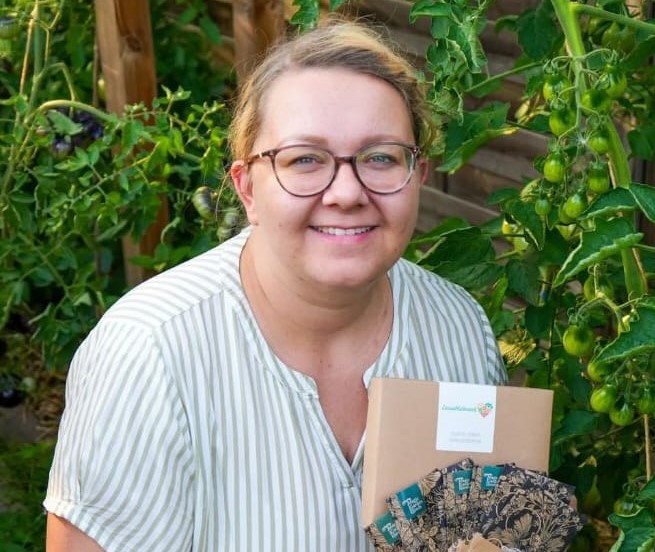
Karen Phillips, Bonsai expert and blogger. Read more about me here

